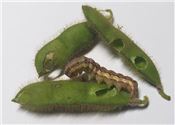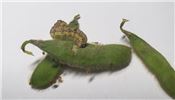Presence Of Soybean Podworm Seen On Maturing Soybeans
DR. RAUL T. VILLANUEVA
PRINCETON, KENTUCKY
Although some soybean fields have already been harvested, there are still fields with some maturing pods, and other double crop fields have developing pods. Although not reported in commercial fields this year, the soybean podworm Helicoverpa zea (also known as the corn earworm, cotton bollworm, and tomato fruitworm) may be feeding on maturing soybean pods. In soybeans, the most serious injury happens when late larval stages (fifth or sixth instars) coincide with pods that are developing. The larvae eat away pod walls and consume seeds (Figure 1), potentially reducing yields.
Although, Figures 1 and 2 are pictures taken of soybean pods from a research plot that is near corn (the corn was planted late with the purpose of attracting a corn earworm infestation), this type of damage may have been occurring in some commercial soybean fields.
Usually, fifth (17.9 mm =0.7 in) and sixth (25 mm =1 in) instar larvae damage pods by creating holes (Figure 2) in them. These large caterpillars are voracious, and if outbreaks occur, they reduce soybean yields. Feeding by small caterpillars on terminals, flowers, and small pods does not reduce yield. In addition, occasionally large caterpillars will cause severe defoliation, but this damage rarely reduces yield.
Management
Planting time is the best resource to avoid soybean podworm damage.
Usually, this pest is most frequently found in late planted fields.
Double-crop soybeans may be more affected than full season. Proper planting is important as leaves may cover the plant canopy before bloom, thus pods may be protected.
Control measures to reduce corn earworm damage should be conducted when an average of one small worm per foot of row is detected. The effectiveness of insecticides for late larval stages is reduced, thus insecticide applications should be completed for small sized larvae.
Insecticide treatment to reduce corn earworm damage is recommended if 5 percent to 10 percent or more of the soybean pods exhibit feeding damage from soybean podworm larvae. ∆
DR. RAUL T. VILLANUEVA: Entomology Extension Specialist, University of Kentucky

Figure 1. Soybean podworm causing damage to seed wall and in the process of feeding on the bean.
Photo: Raul T. Villanueva

Figure 2. Holes caused by podworm feeding on soybean pods.
Photo: Raul T. Villanueva